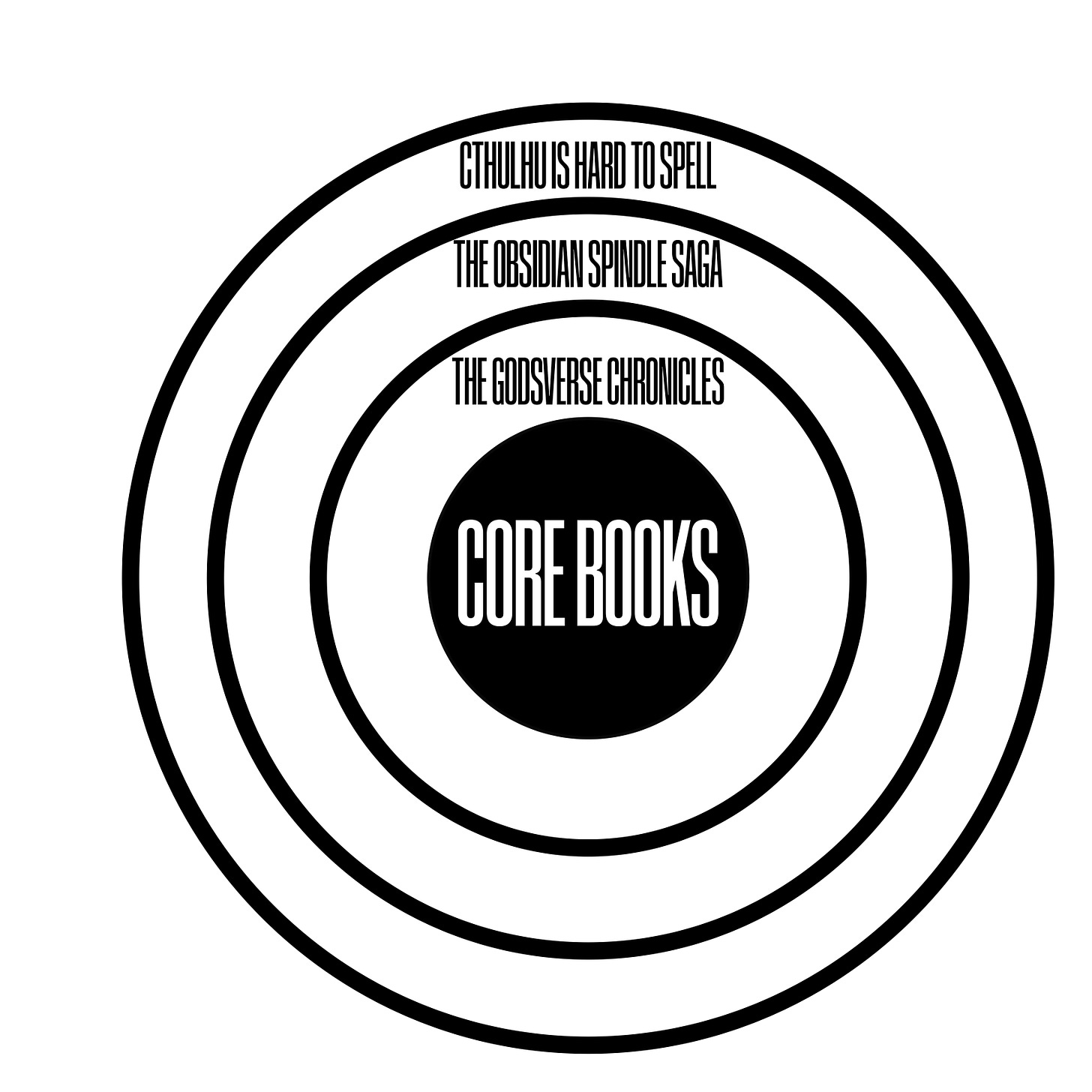The bullseye method for growing an audience
How I've been able to write very weird books AND sell enough to thrive.
Hi friends,
This post is for
, not because I think they will especially resonate with it, but because they have been trying to convince me to write short for months now, and I’m finally listening.I’m a big fan of epic articles, but she is convinced shorter is better, so I’m giving it a try. This is a piece I couldn’t have really written long because there’s just not enough there to warrant it. I’ve also found over the past year that some parts of articles should be pulled out on their own, and I think this would be a good piece of a bigger article, but I don’t have the context for the bigger article yet.
If you like this one, let me know in the comments.
I recommend reading (and spending some time with) my companion articles;
Where to invest your time and money when building an audience for your writing,
Mastering Your Content Calendar Part 1 and Part 2 to help further inform your journey with this work.
If you are not a paid member, you can read everything with a 7-day free trial, or give us a one-time tip.
I write weird books. You might not believe me if you’ve come across me recently, but my first books included an epistolary novel told all in blog posts about a girl trying to prove her father’s suicide was a murder so she doesn’t leave her family home, a grounded sci-fi novel about a disabled boy who meets a homeless alien and has to help her get off the planet, a graphic novel I drew about a pickle that falls into a black hole and has to travel the universe to get back home, and a psychological horror dark fantasy comedy comic about a psychopath that doesn’t know if they are killing people, monsters, or its all in their head the whole time.
Even if you are like “all those sound amazing”, you have to admit none of them are "center of the market” in the way that Deserts, or even Grasslands, think of the market. It’s closest to how a Forest thinks about the market, but there were not even consistent themes in my work back then.
These books, along with Anna and the Dark Place, The Void Calls Us Home, How NOT to Invade Earth, and Worst Thing in The Universe, are what I consider my central canon. If you really love my work, you’ll probably resonate with all these books, but they aren’t likely to resonate with the “general audience”.
Even my first non-fiction book, How to Build Your Creative Career, was originally called Sell Your Soul: How to Build Your Creative Career. It was a joke, a pun based around soul resonance selling, which is a term I started using a long time ago to talk about how to sell creative projects.
All of those books broke even at launch (in fact every book I’ve ever launched has), but unless I was hand-selling the books to people, they didn’t have much traction, and hand-selling a $20 book is really hard, especially ones as niche as what I wrote.
Then, everything changed with the introduction of Katrina Hates the Dead. Even though the story was still not “center of market”, the artist went on to draw for Marvel, so there was a very commercial style attached to it. People started picking up the book without me having to sell it, and that was nice.
Even nicer, people started to buy my other, weirder books, either in concert with their Katrina Hates the Dead purchase or after they finished it. This is where I developed The Bullseye Method.
The idea is basically that you have a core collection of books that are super weird and unsaleable to people because they are just too off-market. Then, you create increasingly more commercial projects to drive people back to your core products.
This is how it looks in my author business.
As you can see, those core books I mentioned are sitting in the middle of everything I do. Those are the “superfan” books. I don’t necessarily want them to be the first thing somebody reads when they come across my work, not because they aren’t great, but because they are weird and might otherwise turn somebody off who would love my work.
The Godsverse Chronicles is my second tier. I’ve done a lot of work to make this series more mainstream over the years as I expanded it from Katrina Hates the Dead and Pixie Dust into a 12-book series. This series deals with mythology, fairies, dragons, and everything that I love about fantasy, but it’s an anthology series, which means you can read any book in any order. Even though the series is now much more marketable, when I first launched it, the series was way weirder. I actually added four books to the start of the series (Magic, Evil, Time, and Heaven) to ease people into the weirdness.
The Obsidian Spindle Saga is the next level up. It deals with everything in The Godsverse Chronicles, but adds a lot of public domain characters and features titles like The Sleeping Beauty, The Wicked Witch, The Fairy Queen, and The Red Rider to hook people quickly and play on the ingrained nostalgia built into them. The other main thing this series has that sets it apart is that it centers a romance. It’s not a romance, but the whole 12-book series is about this romance that will transcend time, space, and even the gods themselves. On top of being my best series, it’s also the most commercial work I’ve ever put out in novel form.
Cthulhu is Hard to Spell expands even beyond that, though, because it wasn’t written by me alone. It’s an anthology series, which means I had dozens of creators helping me push it out. While Lovecraft’s canon is not as popular as fairy tales, having so many amazing creators involved helped make this my most popular series ever.
But even better is that sales of Ichabod Jones: Monster Hunter exploded with the introduction of Cthulhu is Hard to Spell. Horror and fantasy fans suddenly had an easy way into my orbit, and many matriculated into my more avant-garde work.
This is true with my non-fiction, too. Earlier this year I launched This is NOT a Book, clearly a core book, to the audience I built up through my work with Monica and my other work. Even though it didn’t do nearly as well as our Direct Sales Mastery for Authors book, it still made over $5,000 at launch, and people still matriculate there who want to explore the totality of my canon.
Even on this publication, I intentionally write easily consumable, SEO-friendly posts on occasion to attract the maximum number of new subscribers, some of whom will go on to read my more niche articles. I additionally release a serialized novel on my nonfiction publication because I know some percentage of readers will like both and those are the ones I am most interested in delighting with my work. I am less interested in straight audience growth than I am in finding readers who will love everything I write from my books with wide appeal to my weird, niche books.
The beauty of this method is that as your audience expands, the floor of what you can make from your core books rises. Years ago, I launched How NOT to Invade Earth for 5-days and made $3,420 on it. The next year, I launched the audio drama for The Void Calls Us Home and it raised $4,618 . The next year, I launched Anna and the Dark Place and it raised $5,103. A few months ago I launched my Wonderland duology and it raised $5,357.
It’s not an either/or for me. The broader stories support the core books, and I love them all. I have soooo much fun writing The Godsverse Chronicles. I love working with so many creators on Cthulhu is Hard to Spell. I’m obsessed with The Obsidian Spindle Saga. They are my whole heart just like my core books are, but there is intention behind them.
There is intention behind everything I do here, too. I write widely read posts people want to hear so that I can deliver weirder, niche pieces that people need to hear.
It’s down at the core of everything I do. I live in Los Angeles, which has a long tradition of actors doing “one for the studio and one for me”. That doesn’t necessarily mean they love either role less. Sometimes they do, but most of the time they are indulging different parts of themselves with every story.
That resonates with me. Maybe it will resonate with you, too.
Questions to ponder:
How do you decide what to write?
Do you ever write posts for different reasons?
Do you write more center of market, or tend to write weirder?
See you in the comments content warriors!
🧙🏼♂️ Russell
If you are not a paid member, you can read everything in our archive with a 7-day free trial, or give us a one-time tip.






Ha! I’m honoured! (And interested to see how this post feels to you and what it does)... I wonder what actions if any folks will take... who will click what? Who’s here for the chat?!
I’m drawn to your first and second questions at the end and I’ve enjoyed building up more understanding of your journey with books and your passions in writing here! 🦄✨
Russell, I'm learning so much from you. I'll take this away especially: "There is intention behind everything I do here, too. I write widely read posts people want to hear so that I can deliver weirder, niche pieces that people need to hear." For me, at this point, my Substack is the most "for me" project I've ever had (although I think people are connecting with it too), and I think of articles I write for mainstream publications as a "one for the studio."